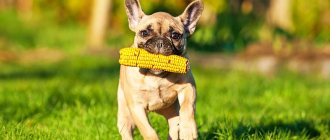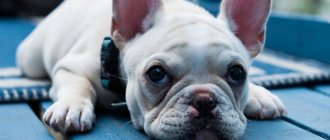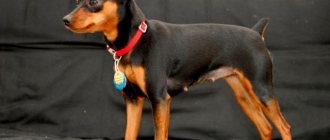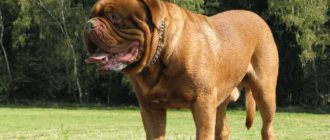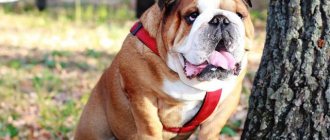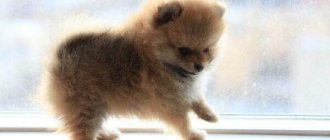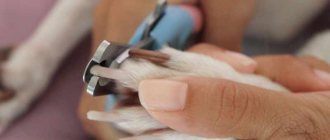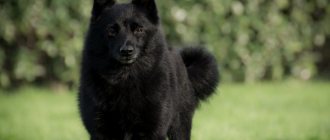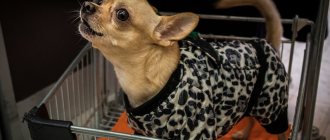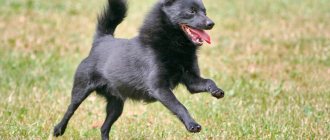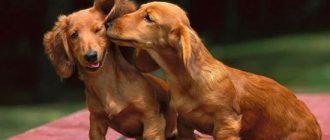Review author: “ZooVita”
Dogs that look so cute that they leave no one indifferent. The description of the French bulldog also states that pets have the peculiarity of snoring, and not only during sleep. These are very good-natured and intelligent dogs; keeping them in the house is a pleasure. The breed belongs to a number of decorative breeds, and therefore requires care and attention. More details about everything in this article.
Breed characteristics
| Short description | |
| Origin: | England |
| Conditions of detention: | In a house or apartment without a garden |
| Purpose: | Companion |
| Color: | Brindle and fawn |
| Wool length: | Short 1-2 cm |
| Adult dog size: | The height of females is 27-35 cm, males are 24-32 cm, weight of males is approximately 8-13 kg, females 9-14 kg |
| Average life expectancy: | 10-12 years |
| Walk: | Requires walking 1-2 times a day |
| Physical activity needs: | Average physical activity needs |
| Fédération Cynologique Internationale (FIC) classification: | Group No. 9 Decorative and companion dogs; Section No. 11 Small Molossoids |
| Puppy price: | Pet class from 20 to 30 thousand rubles, breed from 35 to 45 thousand rubles, show from 50 to 90 thousand rubles. |
Nutrition
The diet of the French bulldog differs little from the diet of other decorative dogs. It is important to decide right away what type of feeding will be the main one - dry food or natural food. The first option is more rational, since premium food is initially balanced and does not cause allergies in dogs. Constant access to clean water is required for any diet.
The bowl should be placed at chest level. As the puppy grows, the height should be adjusted. Monitoring your pet's weight will tell you whether to increase or decrease portions. Small bulldogs are prone to overeating.
It is known that pets are eternal beggars. You should not give in to a pitying look for the sake of your pet’s health; never feed it from the table. Compliance with the feeding regime develops discipline in the animal. Puppies up to 2 months are supposed to eat 4-6 times a day, then as they grow older - 3 times, from 10 months of age - in the morning and in the evening.
Natural feeding includes only good quality products - the pet’s digestion is sensitive to any negative factor. Half of the diet is lean meat - boiled beef, rabbit, lamb. The second half - vegetables, fruits, with the exception of citrus fruits, grapes. Rice and buckwheat porridge and eggs are healthy. You should add fermented milk products and herbs. You should not give sweets, salty, spicy foods.
By-products are allowed only in boiled form. The fish must be sea fish, without bones. The appearance of a rash, peeling skin, and hair loss signal that you need to change foods in your diet. Teeth cleaning is indicated with special treats with a cleansing effect.
History of the origin of the breed
It is believed that this breed traces its roots to English and Spanish bulldogs (Alans). At the same time, the debate about its appearance still does not subside. The British prove that it was they who bred the breed, while French breeders assure that the breed was formed in France. There is no exact information in history about how the breed appeared. It is only known that bulldogs were brought to France by English workers during the Industrial Revolution.
There are many interesting facts known in the history of this breed. Initially, bulldogs acted as fighters. In England, a kind of show was popular where dogs were set against bulls. They drove cattle to death for the entertainment of spectators. In the 30s of the 18th century, such entertainment was banned, and bulldogs moved from the ranks of fierce fighters to the ranks of man’s friends.
Shopkeepers and industrialists often owned dogs because they were good at catching rats. However, the bulldog gradually conquered the higher strata of society. The breed began to be considered elite.
In Russia, this breed began to be bred in the 20th century. Bulldogs first appeared in 1913 at an exhibition in St. Petersburg and from that time gradually became fashionable. Many famous personalities of those times kept French bulldogs.
French bulldog color
The coat tones of these dogs are quite varied. There are monochromatic individuals, often born fawn, brindle, or simply with scattered spots. The most fashionable color now is the blue French bulldog. This is a very noble gray tone with a bluish undertone. Beige, white, cream, and black French bulldogs are also held in high esteem.
Distinctive features
According to the standard, the breed can be described as follows:
- The head is large in size, with folds and wrinkles. There is a furrow between the eyebrows. The back of the head is not too prominent and there is a clear transition from the forehead to the muzzle. The bones of the upper jaw and nose are shortened.
- The muzzle is snub-nosed with an extended dark lobe. It is because of this structure that the breed often experiences breathing difficulties.
- lips are fleshy, slightly drooping, and black in color. They close in the middle and hide their teeth behind them.
- The jaws are strong, the lower one is pronounced and slightly moved forward.
- The eyes are large, round, outlined.
- The ears are medium in size, round, thin, wide at the base.
- The neck is short but muscular and slightly arched.
- The body has a slight rise from the withers to the hind legs - which is typical for this breed.
- The back is massive and strong.
- The chest is deep and cylindrical in shape.
- The abdomen is toned, without sudden changes.
- The tail is short, set low with a tapered end.
- Forelegs with short forearms.
- The paws are shaped like a cat's - round, with claws connecting to each other.
- The hind limbs are more developed, have pronounced muscles, and are positioned more vertically.
Appearance of French Bulldogs
The description of the French bulldog breed states that it has a massive, strong build, a small tail, a large head, and large ears. The dog is quite compact, weighing no more than 15 kg. Bitches – up to 10 kg. The height at the withers of adult individuals reaches 30-35 cm.
The French Bulldog's legs are strong and very muscular. The forelimbs are slightly shorter than the hind limbs. The head is wide, almost square. There are quite a few wrinkles on the forehead. The nose is not flattened, but gentle. The forehead is slightly convex. The eyes are big. In some individuals they are slightly outstretched.
The coat is beautiful, shiny, short. The coat is thin, without undercoat, so the pet can hardly tolerate extreme cold. Another feature is difficulty breathing with wheezing and snoring.
Many people call French bulldogs “grunts.” It is considered normal if a pet begins to sniffle when significantly excited. Let's say night snoring. If the snoring is strong and constant, it is advisable to show the dog to a veterinarian to rule out respiratory tract pathologies.
Photo of an adult dog
Caring for a dog at different times of the year
Short fur and the absence of an additional layer of fur do not protect the pet from inclement weather. Therefore, he needs clothing for the season.
It is better to buy a waterproof suit with a hood and an insulated sweater. For summer you will need a Panama hat, and for the autumn-winter periods an insulated hat.
Photos of puppies
Kinds
Dog handlers distinguish classic colors and mixed, non-standard ones. The first include:
- Pale yellow.
- Brindle.
- Ginger.
- Bicolor (black and white with exactly the acceptable size of spots and tans).
- Cream.
Types of rare colors unacceptable by standards:
- White with black spots.
- Mousey.
- Smoky.
- Liver.
- Blue.
- Tan.
- Pure black.
Below, you will learn more about the colors and look at photos of all types.
“Defective” colors do not affect the popularity of the breed; on the contrary, bulldogs of rare colors are highly valued among buyers, despite the fact that such animals will not be able to take part in exhibitions.
Black
Black dogs are outside the breed standard. They can have different degrees of color intensity (variations of dark brown, brown and tan, black and tan), depending on the genes. A black French bulldog may have a white shirt front and a white collar. Owners of dogs of this color are advised to closely monitor their pet in the heat - black bulldogs can overheat in the sun. It is also necessary to carefully examine the dog after a walk - ticks, wounds or other damage may not be noticeable on dark fur.
Gray
Gray and gray-blue (mouse) colors are also not accepted by the breed standard. However, dogs of these colors are quite common and are popular. The gray color of the coat varies, from light to metallic, it can be plain and “highlighted”, with tan marks. The coat of dogs of this color is short, shiny, there may be some white spots on the chest, but most often the color is uniform throughout the body.
Redheads
The red color is a variety of fawn. A bulldog of this color will be welcome to be seen at exhibitions, but with reservations: the presence of white spots on the animal’s body is allowed, except for the belly, neck and chest. Red dogs may have a black mask on their face or brindle markings all over their body. Red is the main color on which fawn marks, spots, masks, and so on are located. Red is considered a variety of red; it is considered one of the elite colors of French bulldogs.
Breed standards are guided by a fairly simple rule: everything that exists in nature is accepted for breeding, for example, red - a natural color obtained without the participation of breeders.
Blue
Blue color is a type of gray, but you can distinguish it, as they say, by eye. The blue puppy has a clay blue coat that is shiny and silver with a visible hint of blue. Such dogs look elegant, but are not approved by the standard. These bulldogs often have blue eyes, which makes the puppies even more popular among buyers. Blue Bulldogs may have white patches on the chest, but most often it is a solid color throughout the body, with no blotches or spots. Official breeders do not accept such bulldogs for breeding, since the blue gene can produce blue and lilac puppies, which is unacceptable for show animals.
Merle
Merle or merle is a marbled coat color. The breed standard does not recognize him. Bulldogs are unevenly colored, there are three colors, on the body there are fuzzy spots of different sizes and shades, most often coffee, brown and white alternate. With the merle color, as a rule, there is no usual mask on the face; dogs often have eyes of different colors. If bulldog owners can only be pleased with such features, dog experts consider merle to be a genetic deviation.
Chocolate
Chocolate color is a uniform, rich brown or brownish brown with a slight sheen. There may be different shades, but in general the color will always be monochromatic. Such bulldogs may have longitudinal white spots on the neck and belly; there is no mask on the face. The chocolate color is artificially bred by breeders; the bright brown coat is considered a defect. However, if it is a variation of brindle or fawn, then it will be accepted as the standard.
Brindle
Brindle color is considered the most common color among French bulldogs. It can be recognized by the characteristic alternation of red and black stripes on its fur. There may be milky markings on the chest and neck, and a mask on the muzzle. Color is transmitted genetically, brindle is a dominant trait, puppies of such colors are distinguished by good health, they are mobile and active. The breed standard accepts the presence of patches of black or red hair on the coat, which give this color its name.
Fawn
Fawn color includes various shades - from red, brown (cappuccino) to wheat, light. The standard allows for this color to have various spots on the forehead, chest, neck and belly.
If the spots are located in other places, the puppy is rejected.
The most common colors of dogs are:
- Fawn with black hairs (speckles).
- Fawn - brindle (there are black transverse stripes).
- Fawn with spots and white-fawn. According to the standard, spots should not occupy an area of more than 20% of the total background.
Features of character and behavior
Representatives of the breed are very active. They are famous for their openness and good nature. The French are quite smart, but difficult to train because they are not eager to obey their owner. This is because the breed was created not to carry out official commands, but to build unique social relationships between the pet and its owners, capturing their mood.
This breed is considered universally suitable for both large families and non-family individuals who are elderly or disabled.
Advantages
Keeping a representative of this breed has certain positive aspects:
- With good upbringing, they are capable of showing aggression towards other four-legged animals only in an emergency situation.
- They never raise their voice without reason, within the confines of the house.
- They easily find contact with children, participating in their games with pleasure, but within reason. It is better if such games take place under the supervision of elders in order to avoid unpleasant incidents.
- Smart, inquisitive, good and loyal friends. Obedient. However, in the character of a bulldog there is always a certain amount of laziness and stubbornness, which owners are advised to control through training and encouragement of their four-legged friend.
- Able to sense the mood of their owners.
Flaws
French bulldogs have a number of disadvantages that you should pay attention to when deciding to get such a pet:
- They are capable of showing character: upending the house during an outburst of excessive activity, biting if they don’t like something, getting offended.
- They are often lazy. Therefore, without timely training, they stop listening to the owner.
- They cannot stand loneliness and need constant attention. This breed is not suitable for breeders who do not have time to play with their pet.
- Fearless beyond measure - they can be maimed by representatives of larger breeds due to bouts of aggression.
- Not suitable for guarding a private home - the breed is designed to be kept at home.
Flaws
Pets, like people, have their own personalities. This means that they also have shortcomings that can either be corrected with the help of competent education or accepted.
Due to the peculiarities of their hair, French bulldogs can easily get sunstroke in the summer and freeze in the winter. That is why you cannot take your animal out into the scorching sun, and in cold weather it is better to dress the animal in a charming winter overall.
Due to the fact that the bulldog is quite large, it is quite difficult for him to swim. The presence of many folds on the face is not always a plus: fungus and abscesses can develop between them, which is why constant examination by a veterinarian is important.
Another disadvantage of the dog is snoring, which is associated with the structural features of the muzzle, excessive salivation and the release of gases during sleep.
Despite his calm character, the “Frenchman” can behave unexpectedly: for example, cause a pogrom, be very offended, or even bite.
If a dog is poorly raised, it can grow up lazy or even aggressive towards other animals. Therefore, it is important to think about raising your pet in time.
Care and maintenance
The French should pay special attention to hygiene. Therefore, he needs to be taught these procedures from the first day he appears in the house. You should systematically examine your pet’s ears, and treat them with ear sticks as they become dirty.
Your pet's eyes require daily treatment with moisturizing wipes.
Teeth are the Bulldog's weakest point and need to be looked after carefully and regularly. They are prone to various diseases and rapid wear.
For this reason, the dog should not be fed bones. For preventative purposes, teeth should be brushed with a dog toothbrush, and the animal should also be given treats with a cleaning effect. The dog's nails should also be trimmed.
Nutrition
The calorie content of the menu depends on the dog’s lifestyle. If she is active, then it should be more nutritious than that of a couch potato. The main product is meat, it should make up 60-70% of the daily menu. The best option is considered to be low-fat rabbit meat, lamb, horse meat, and veal. It can be given raw.
Calculating the daily dose is simple. It is 20 grams per 1 kilogram of animal weight.
Meat can sometimes be replaced with fish, but not more than 1-2 times every 10 days. River fish must be boiled, sea fish can be given raw. In this case, it is necessary to remove the bones from it.
The remaining 20-30% of the diet is filled with cereals, vegetables, and dairy products . The porridge can be anything, over time the pet will decide which one he likes best. It is advisable to cook it in water without salt, adding meat and vegetable ingredients at the end of cooking. During cooking, it is allowed to add vegetable oil.
Trying to diversify a pet's menu, owners have every chance of harming its health. For example, you cannot feed your dog dairy products and meat at the same time.
Milk should not be given to mature dogs; their stomachs have difficulty digesting it. Plant food (if the dog eats it) can be given both raw and boiled. Suitable: carrots, cabbage, eggplant and other vegetables. If your French Bulldog prefers fruit, it is best to give it as a treat. This will be an incentive for training.
There are several types of foods that should not be in a bulldog's diet:
- potatoes, onions and garlic;
- flour and confectionery products;
- smoked and pickled products;
- bones (tubular, hard);
- fatty meats (pork).
Food with seasonings, sauce, ketchup, as well as fried and fatty foods are undesirable.
If dry food is used, you should choose only high-quality products. If your dog has allergies, you should pay attention to hypoallergenic products; they are available in the holistic food line.
We recommend that you read a detailed article on the topic: “How and what to feed a dog: types and characteristics of nutrition.”
Health
This is a fairly healthy breed. But if you don’t care for her properly, she’s unlikely to live long. That is why you should be attentive to the care of your animal and its nutrition, get vaccinated on time and, if necessary, immediately contact a veterinarian.
Vaccinations
There are many known diseases that French Bulldogs can suffer from. Most of them can cause the death of a dog. Modern medicine makes it possible to protect animals from the most dangerous diseases thanks to a set of vaccinations against the following diseases:
- Rabies;
- Plagues of predators;
- Parvovirus inflammation;
- Leptospirosis;
- Infectious hepatitis;
- Adenovirus;
- Parainfluenza.
The following vaccination model is currently used:
- 6 weeks - immunization against enteritis, jaundice, adenovirus, after 14 days - secondary vaccination, then - a year later - every year;
- 10 weeks - anti-plague vaccination;
- After 16 weeks - vaccination against leptospirosis, after 6 months - revaccination;
- 7 months - vaccination against distemper, then a year later - every year;
- After 8 months - rabies vaccine.
Two weeks before vaccination, you should pay attention to the condition of the puppy. Is he active, how does he eat, drink, how many times does he go to the toilet?
It is also necessary to measure its temperature. The temperature of a puppy is normal at 38-39 degrees, for an adult dog at 38-40 degrees.
Treatment against parasites should be carried out 7-12 days before Because a puppy infected with worms may not tolerate vaccination.
Important article on the topic: “Everything you need to know about dog vaccinations.”
Diseases
Due to the special structure of the nose, eyes and body, the French Bulldog can develop health problems. Particularly common diseases include:
- Food insect allergy;
- Cataract;
- Dermatitis and suppuration of the fingertips;
- Turn of the century;
- Hypotrichosis (hair loss);
- Stones in the kidneys;
- Colds;
- Bracheocephalic syndrome;
- Obesity;
- Problems of spinal development.
Often puppies of this breed suffer from diarrhea, which can be caused by a sudden change in menu. In addition, diarrhea can be associated with infection, worms, colds, teething, and intestinal infections. This can be treated with activated charcoal and a dry diet. If the condition does not improve within a day, you should immediately contact your veterinarian.
Walk
It is not necessary to walk a French bulldog for a long time . These dogs are calm about being outside and can stay at home with their owner. However, you will still have to take it out a couple of times a day.
Due to the specific nature of the bulldog, you need to follow some rules when walking:
- Duration . Despite the common characteristics of the breed, each Frenchman has his own character. One is sociable and active, the other is a typical homebody. Therefore, how long a dog will walk depends on its character.
- Place of celebration . A lawn with dense soil is what you need for an active walk. It is healthier to walk on lawns, clearings and similar places than on asphalt. Do not overload the dog's spine with unwanted steps and crossbars. Moreover, this is contraindicated for puppies.
- Cloth . The Frenchie has short hair, so he is very sensitive to heat and cold. It is worth reducing the walking time at high temperatures. A warm jumpsuit will keep your pet warm in winter.
- Communications . It is worth introducing the dog to the outside world, other animals and people, and then walks will be a pleasure for both the dog and the owner. These dogs are practically not aggressive, but any desire to fight must be suppressed.
Grooming
It is not necessary to bathe your bulldog too often. After a walk, you should use wipes to clean the animal. Full bathing without special need is carried out once every 2-3 months. To do this, you should fill a bath of water or a basin and put the dog there. When bathing, be careful not to get shampoo into your eyes and ears. It is more convenient to wash off the foam from the animal using a watering can with low pressure. After bathing, the animal is wrapped in a towel, dried with a hairdryer and released into a draft-free room. It is better to take a walk after swimming 3-4 hours later.
Caring for the coat of this animal is not difficult. Dogs of this breed practically do not shed, and their fur is odorless. But if the fur becomes dull, dandruff and odor appear, then most likely the pet is sick. In this case, you need to consult a veterinarian and exclude all cosmetic substances.
A bulldog comb should have fine teeth . Even better is a massage brush. When a bulldog sheds heavily, it is better to bathe him with a special product. Brushing the coat with a massage brush will help remove loose hair. The French don't get their hair cut or shave. It is allowed to apply balms or conditioners to wet wool. Any product for dogs with short hair will do.
Conclusion
French bulldogs are charming short dogs that can brighten up your drab everyday life, cheer you up and support you at any time.
Dogs that grunt slightly can make anyone smile, but in order to live in harmony with your pet, it is important to correctly and promptly develop the positive aspects of his character and the characteristics of the breed.
We recommend that you look at photos of a French bulldog on the Internet in order to decide to get a representative of this dog breed.
Mating
In the French, adulthood occurs earlier than the body's readiness to reproduce. For females it is 6-8 months , for males it is 1-1.5 years . At this time, they have a strong need to mate. However, it is better not to allow it during this period. Since females are ready for bearing fruit only at 1.5-2 years, and males for insemination at 2 years.
Girls go into heat every six months, and the discharge appears, first colorless, then with blood, and then colorless again. The genitals swell, indicating the beginning of this process. The main thing is to notice the onset in time, which will help determine the exact time of ovulation.
In bulldogs, ovulation occurs at the end of the second week after the start of estrus. The veterinarian will help determine this period more precisely, as displacements are possible. If the female does not appear in heat after maturation, then you should contact a veterinarian.
Read a detailed article on the topic: “Everything you need to know about breeding dogs: appropriate age, what to do if it doesn’t work out, rules and tips.”
Care for skin folds
Folds should be systematically inspected and wiped with a clean towel to prevent the formation of inflammation and infections. If you notice diaper rash on your pet's body, use diaper rash cream for small children.
Treat your dog's nose 2-3 times a week with a swab of olive oil (you can sometimes moisten it with vitamin E capsules). If this is not done, then crusts will form on the nose, and the dog will also be debilitated by dryness.
Key points in training
The French are very kind and get along well with children. The Bulldog is stubborn and a little lazy and will not listen right away. You should not give up training if your dog suddenly stops obeying. It is possible that the dog simply ceased to understand the owner. To continue training, the dog needs to calmly explain what they want from it.
When training, you should alternate between rewards and punishments. Because this is the best method for raising bulldogs.
Read about how to properly train a dog in the article: “Training a puppy: effective methods from dog handlers, learning commands at home.”
You need to start training your puppy as soon as he appears in the house. Don't forget to repeat the commands you've already learned. To begin with, you should learn the simplest commands: sit, lie down, voice.
How to care for an animal's fur?
To do this, just use a damp towel, which will remove traces of dirt. It is not recommended to bathe your dog regularly.
The pet prefers regular brushing with a soft massage brush. It will allow you to quickly remove old undercoat and normalize blood circulation in the back, head and tail.
How to choose a puppy
The puppy should be picked up no earlier than 1.5 months from birth . By this time, he should be vaccinated and examined by a doctor. You should find out who the puppy’s parents are and what his pedigree is, how he was kept and what he ate.
You can determine whether a dog is healthy visually. In a healthy dog :
- Living identical eyes;
- The ears are clean and odorless;
- Black nose;
- Paws are straight,
- Coordinated movements;
- Pink oral cavity;
- Correct bite;
- Teeth without defects.
A healthy dog actively plays and has fun . The puppy is sociable and makes contact. It is worth paying attention that the puppy may react negatively to the touch of strangers, but will not show aggression.
In conclusion, it is worth saying that the French bulldog has always been considered a dog for high society. He was always the center of attention at parties. The sight of this dog evokes affection: its upturned nose, voluminous chest, and powerful paws. This little dog has all the qualities of a fighting dog and is ready to protect its owner at any time. A soft nickname will suit the Frenchman. This breed is quite suitable for those who are getting a dog for the first time or who lead a measured lifestyle. The Frenchie will easily fit into any family and will feel good even in a small house or apartment.
5 / 5 ( 3 voices)
Claws, ears, eyes
Claws are trimmed only when they grow too long.
- The ears are treated to protect against dirt with a cotton pad soaked in moisturizing lotion.
- You can clear mucus from your eyes with a disk soaked in chamomile infusion.
- Never use tea or sulfacetamide on your dog's eyes.
- They only cause an increase in inflammatory processes and do not help protect the eyes.
Rare
Breeders are working on developing new shades, often producing exotic colors for dogs. Among bulldog owners, white, lilac and blue ones are especially valued. All these shades are extremely rare. Not all exotic colors are allowed by the standard and can be used for further breeding. For example, purple and black are outside the standard, but cream and bicolor are acceptable.
Bicolor
Bicolors include two-color dogs, among which the most common type is black-white or white-black (depending on which color is the main one). In this case, the standard allows color if the spots are located on the back, sides, head (ears, forehead, cheeks) and occupy no more than 20% of the total body area. Limited spotting is allowed - the spots occupy a minimum area of the main color, located on the chest, paws, and on the neck in the form of a tie.
Cream
Cream-colored dogs (also a type of brindle) have light noses, lips and eyelids; this is the main difference between the color and all others. This color is accepted by the American breed standard, but it is extremely rare and therefore highly valued among breeders.
Blue
If there is a mention of blue French bulldogs, then most likely we are talking about a blue dog. They just call it differently to more specifically describe the color, saying that the shade is rich and rare. The blue coloring of bulldogs is gray and silver. This color is very beautiful, but a pet of this color will not be allowed to the exhibition, this is a defect.
Red
Red bulldogs belong to the elite group of colors. Such dogs are valued among dog handlers, they are bred, and they conquer experts at various exhibitions. Red is a rich shade of red or fawn. The cost of such dogs is quite high precisely because of their high breeding.
White
Snow-white bulldogs are an incredible rarity, most often they are congenital albinos. This is a easily soiled color that requires special care. Many puppies that appear white at first glance turn out to be brindle or cream. White color is not allowed by the standard.
Nurseries in Russia
Dogue de Bordeaux is a fairly popular breed, so there are many nurseries specializing in their breeding.:
- Star Shaine, Yekaterinburg;
- Winner Show, Moscow;
- "Madrid Courtyard", Moscow;
- Valents House, Moscow;
- Maximovs, Moscow region;
- Empire Of Demons, Moscow;
- “Giant Pets”, St. Petersburg;
- Dorsdorf, Moscow.
Purchasing a puppy from a kennel guarantees that it is a purebred and healthy representative of the breed.
Black
View this post on Instagram
Posted by Barney French bulldog to Moscow (@puppies_from_barney)
The black bulldog is the rarest variety. A continuous color is obtained by crossing brindle dogs for a long time.
The black-haired French pet is excluded from participation in competitions and breeding. Therefore, the black cubs born are castrated. The bulldog is bought exclusively as a companion; in terms of character traits, it is in no way inferior to the varieties recognized by the standard.
It is necessary to distinguish between solid and black-and-white bulldogs. The intensity of the color is influenced by the genetic characteristics of the individual. Since the variety was obtained by crossing brindle dogs, in the vast majority of cases the body is not black, but motley. It’s just that the specks and stripes are small, almost merge with the black background, and are difficult for human eyes to notice. The chest and limbs are decorated with white and beige spots; less often, markings cover the back.
Description and standard
Dogue de Bordeaux is an athletic dog with a well-built, muscular, squat body. They have a rather menacing appearance, inspiring fear in those around them who are not familiar with this breed.
Breed standard:
- the head is large, wide, angular, trapezoidal in shape;
- the muzzle is wide, not too long, with symmetrical folds of skin above the eyebrows, near the lips, on the cheeks and above the nose;
- the jaws are powerful and strong, the bite is undershot;
- the nose is wide, upturned, flat, the nose is brown, black or reddish in color;
- eyes are almond-shaped, set wide, color varies from black to hazel;
- the ears are triangular in shape, small, set high;
- limbs are straight, strong, muscular, set parallel.
The coat is thin, short and soft . The guard hair is a maximum of 2 cm long, the undercoat is short and not dense. Shedding is moderate.
